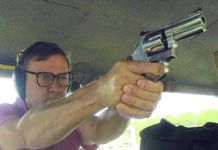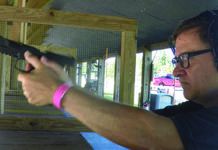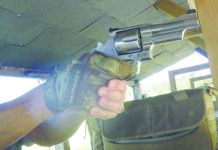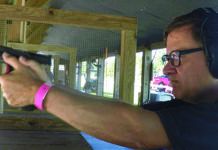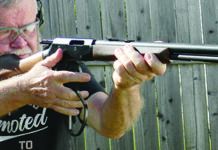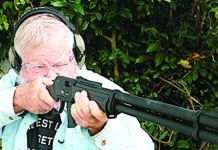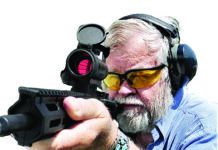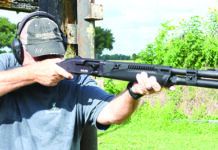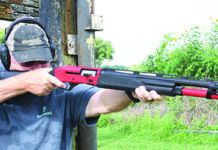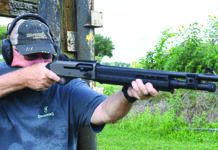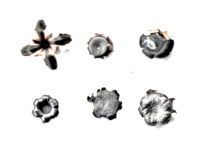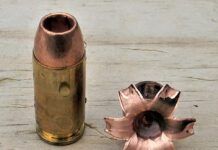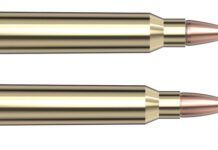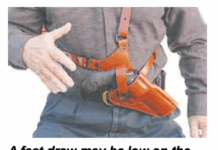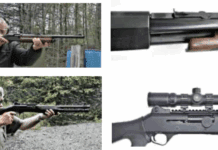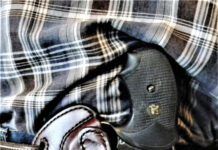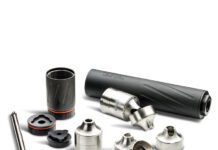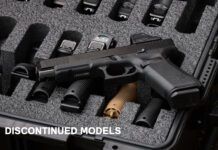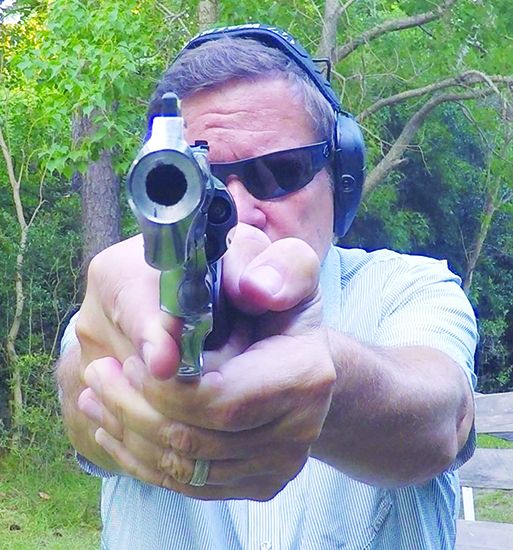Offering custom treatments on revolvers is a tradition among wheelgun manufacturers. In fact, Smith & Wesson, Ruger, and Taurus all produce custom-shop variants of popular models. These gun receive extra fitting handwork, along with premium finishes and tuned actions. Many are also tweaked for a specific task, such as everyday carry (EDC), competition, or a viable choice as a fancy BBQ gun. We acquired three revolvers given such glam and performance makeovers at the factory:
● The S&W Performance Center Pro Model 640 takes a factory J-frame and transforms it into a very capable EDC option.
● The Taurus Model 605 Executive is one of the nicest 605s we have ever handled. Taurus has given the Executive treatment to a few of their revolvers. All of these guns are made in Brazil and assembled by one gunsmith from start to finish.
● The Ruger SP101 Match Champion evolves the ugly duckling SP101 into a swan with beauty and performance.
All three revolvers use a small frame; hence, they have five-round capacities. They also share high-visibility sights, with some being better than others. Barrels lengths varied from 2 to 4.2 inches. The Taurus and the Ruger have double-action-to-single-action triggers, while the S&W has a DAO trigger. Grip sizes ranged from small on the S&W and Ruger to medium on the Taurus. Because these revolvers vary quite a bit from each other, in this evaluation we’re comparing the custom gun to similar guns we’ve handled by the three makers in the past.
With that said, we feel that all three of these revolvers showcase the manufacturers’ factory-customization skills, but of course, these upgrades and treatments come at an additional cost, about $600 starting with the Taurus and upwards to $800 for either the S&W or Ruger. Is the custom work worth the extra dinero? We think it is, depending on what you are looking for. All of these revolvers performed well. Yes, you’ll see our gripes about their double-action trigger pulls. One would think a factory-custom revolver would have a DA trigger-pull weight in the single digits. On the plus side, there was not a lot of stacking in DA mode. The grips allowed use of a strip-style speed loader, but empties hung up on the edges of the grips. In the end, the beauty of these guns is in the eye of the beholder.
How We Tested
All of the revolvers checked out with proper cylinder-to-frame headspace and barrel-and-chamber alignment. As a reminder, the typical space from the forcing cone to the front of the cylinder should be from 0.004 to 0.010 inches, with the Taurus at 0.005 inch, the Ruger at 0.006 inch, and the Smith at 0.009 inch. A larger cylinder gap can allow gases to escape from the side of the gun when shooting, which we experienced with one of the revolvers.
To level the playing field for accuracy testing, due to the S&W being a DAO carry-type revolver, we set targets at 15 yards. The Taurus and Ruger we fired in single-action mode at 15 yards. At 7 yards, we tested for speed and accuracy using IDPA cardboards targets with perforated zones. All speed shooting was done in DA mode, and we spit lead out of these revolvers as fast as we could, pushing ourselves to the edge of our ability while not eroding our accuracy. There were very few hits outside the A zone once we acclimated to the guns, and then we clustered shots into large holes.
Test ammo consisted of 38 Special, 38 Special +P, and 357 Magnum choices; Aguila 357 Magnum ammo loaded with 158-grain SJSP bullets, Blazer 38 Special +P loaded with 125-grain JHPs, and Armscor 38 Special with 158-grain FMJs. As you might assume, recoil was noticeable with 357 Mag ammo and pleasant with 38 Specials.
We used the S&W with and without the moon clips, and we used Tuff Products QuickStrips ($12; TuffProducts.com) speed loaders on all of the revolvers. The Tuffs are flexible strips of polymer that hold cartridges in a row. You can load two chambers at a time with the QuickStrips, and they lay flat in a pocket for concealed-carry reloads.
All of these 357s performed well, but there were differences when the data was tabulated and empties picked up. Here’s what we thought:
Ruger SP101 Match Champion 5782 357 Magnum
$798
Gun Tests grade: A-
This SP101 is tweaked for speed and accuracy. The small grip allows for a high hold to better manage recoil. The long underlug barrel helps to control muzzle flip. The front fiber-optic sight pops for fast acquisition. The DA trigger was too heavy.
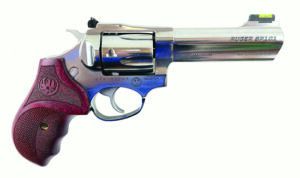
| Action Type | DA to SA Revolver |
|---|---|
| Overall Length | 9.1 in. |
| Barrel Length | 4.2 in. |
| Sight Radius | 5.1 in. |
| Overall Height | 5.1 in. |
| Maximum Width | 1.3 in. |
| Weight Unloaded | 30.0 oz. |
| Weight Loaded | 32.0 oz. |
| Cylinder Gap | 0.006 in. |
| Capacity | 5 |
| Frame | Bright stainless steel |
| Barrel | Bright stainless steel |
| Cylinder | Bright stainless steel |
| Frame Front Strap Height | 2.6 in. |
| Frame Back Strap Height | 3.5 in. |
| Grip | Altamont checkered, stippled hardwood |
| Grip Thickness (Maximum) | 1.2 in. |
| Grip Circumference (Maximum) | 5.0 in. |
| Front Sight | Fiber optic, dovetailed base |
| Rear Sight | Adjustable notch |
| Trigger Pull Weight (Double Action) | 13.0 lbs. |
| Trigger Pull Weight (Single Action) | 6.0 lbs. |
| Trigger Span (Double Action) | 3.2 in. |
| Trigger Span (Single Action) | 2.7 in. |
| Safety | Internal transfer bar |
| Warranty | None written |
| Telephone | (336) 949-5200 |
| Website | Ruger.com |
| Made In | U.S. |
We are not sure why this SP101 variant is named Match Champion. Most revolver competitions favor six-shot revolvers. The SP101 is a five-shooter, and that would be a liability since you would need to reload, adding precious time to your score. Or, IDPA’s Back Up Gun Revolver (BUG-R) Division allows five or fewer rounds to be loaded for revolvers or pistols, but the revolver barrel requirement is 2.5 inches or shorter, so the Match Champion wouldn’t qualify there either.
The Match Champion looks like it is all barrel and not enough grip. Once we got over the name and the awkward look, we found this SP101 to be one of the more unusual and more likable SP101s we’ve handled, and we’ve tested a bucket load of SP101 revolvers over the years. In our opinion, they are built like a brick outhouse and work every time. This one does, too, and it is sharp looking to boot.

The stainless-steel barrel, cylinder, and frame have such a high polish they look like they’re chromed. The Altamont laminated wood grip with rosewood finish contrasts beautifully. In hand, the balance is just forward of your trigger finger.
The 4-inch-barrel sports a full lug that is tapered at the muzzle for easy holstering. The muzzle has a deep 11-degree crown. The top of the barrel is serrated for glare reduction and aesthetics. The left side is a billboard for Ruger, with a roll-marked model name, caliber, and logo. The left side is perfectly shiny and void of roll marks.
The front sight is a green-fiber-optic post that absorbs light and whose base is dovetailed into the barrel. The rear sight is a fully adjustable target style sight with a plain square notch cut out. The notch provides just enough space on either side of the front post for quick aiming. We would have liked the rear facing edge of the rear sight to be serrated to reduce glare. Still, this simple sight set up is easy to aim with. The rear sight needed to be adjusted and centered with the post, which required the use of a flat-blade screwdriver. The direction is not indicated on the adjustments, which means trial and error until you get it right, or refer to the manual and get it right the first time.
The cylinder has nicely chamfered chambers for more user-friendly reloads, a full-length ejector rod that clears empties, and the cylinder is tapered from the start of the flutes to the front of the cylinder for easier holstering.
The SP101 uses a triple locking system on the cylinder. A detent in the front of the crane locks into the frame; the pin in the ejector mates with the rear of the frame and what Ruger calls the cylinder latch (which S&W calls the cylinder stop). This is in the bottom of the cylinder window. Ruger calls the cylinder latch, the latch used to open the cylinder, a crane latch. It’s a Ruger thing, just go with it. This set up means there is hardly any wiggle in the cylinder. No doubt this SP101 is built for high round counts that would normally rattle a lesser revolver to pieces.
The laminated wood grip is made by Altamont and is checkered and stippled with nice texture. It also has some palm swell, finger grooves, and thumb rests. It fit an average shooter’s hand size perfectly. The grip looks small, but offers excellent control.
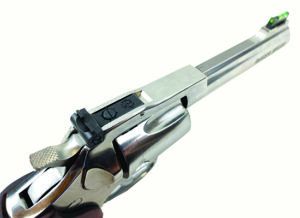
The best accuracy came from Armscor 38 Special ammo. It produced a best group that measured 1.58 inches. Average was 1.59 inches. The SP101 liked the 38 Special load. The Blazer 38 Special +P load gave us a best group of 1.99 inches and average of 2.00 inches. The hot Aguila 357 Magnum ammo had a best group that measured 2.12 inches and averaged 2.65 inches. It also had the highest muzzle velocities of all the revolvers due to the 4-inch barrel.
The Match Champion was the heavyweight of the three wheelguns tested here, weighing in at 30 ounces unloaded. That was due to the 4-inch barrel. We appreciated the extra weight, especially when shooting 357 Magnum rounds. The length of the barrel, weight, and high grip hold allowed us to manage recoil and muzzle flip. We ripped through the center-of-mass A zone with no issues, even with the 13-pound DA trigger pull. Staging the trigger was easy once we were accustomed to the stroke, and we could be surgical with the small A-zone head shot.
Our Team Said: The Match Champion is a shiny, well appointed wheelgun that would be good choice for a showy BBQ gun in a tooled leather holster. While it has the right amount of bling, it also performs well. We dinged it a half grade due to the heavy trigger pull.
| 38 SPECIAL/357 MAGNUM RANGE DATA | |||
|---|---|---|---|
| Aguila 357 Magnum 158-grain SJSP | Ruger SP101 Match Champion | S&W Model 640 Performance Center Pro | Taurus 605 Executive |
| Average Velocity | 1229 fps | 1026 fps | 1061 fps |
| Muzzle Energy | 530 ft.-lbs. | 369 ft.-lbs. | 395 ft.-lbs. |
| Smallest Group | 2.12 in. | 1.87 in. | 2.26 in. |
| Average Group | 2.65 in. | 2.73 in. | 2.38 in. |
| Blaser 38 Special +P 125-grain JHP | Ruger SP101 Match Champion | S&W Model 640 Performance Center Pro | Taurus 605 Executive |
| Average Velocity | 995 fps | 890 fps | 963 fps |
| Muzzle Energy | 275 ft.-lbs. | 220 ft.-lbs. | 257 ft.-lbs. |
| Smallest Group | 1.99 in. | 2.27 in. | 1.52 in. |
| Average Group | 2.00 in. | 3.04 in. | 1.65 in. |
| Armscor 38 Special 158-grain FMJ | Ruger SP101 Match Champion | S&W Model 640 Performance Center Pro | Taurus 605 Executive |
| Average Velocity | 897 fps | 830 fps | 839 fps |
| Muzzle Energy | 282 ft.-lbs. | 241 ft.-lbs. | 247 ft.-lbs. |
| Smallest Group | 1.58 in. | 3.41 in. | 1.33 in. |
| Average Group | 1.59 in. | 3.79 in. | 1.35 in. |
To collect accuracy data, we fired five-shot groups from a bench using a rest. Distance: 15 yards with open sights. Velocities and energies were recorded using a Garmin Zero C1 Pro chronograph.
Written and photographed by Robert Sadowski, using evaluations from Gun Tests Team members. GT



